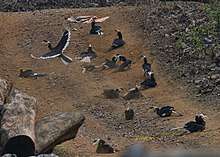Malabar pied hornbill
The Malabar pied hornbill (Anthracoceros coronatus), also known as lesser pied hornbill, is a bird in the hornbill family, a family of tropical near-passerine birds found in the Old World.
| Malabar pied hornbill | |
|---|---|
-3c.jpg) | |
| Male | |
_Photograph_by_Shantanu_Kuveskar.jpg) | |
| Female | |
| Scientific classification | |
| Kingdom: | Animalia |
| Phylum: | Chordata |
| Class: | Aves |
| Order: | Bucerotiformes |
| Family: | Bucerotidae |
| Genus: | Anthracoceros |
| Species: | A. coronatus |
| Binomial name | |
| Anthracoceros coronatus (Boddaert, 1783) | |
Taxonomy
The Malabar pied hornbill was described by the French polymath Georges-Louis Leclerc, Comte de Buffon in 1780 in his Histoire Naturelle des Oiseaux.[2] The bird was also illustrated in a hand-coloured plate engraved by François-Nicolas Martinet in the Planches Enluminées D'Histoire Naturelle which was produced under the supervision of Edme-Louis Daubenton to accompany Buffon's text.[3] Neither the plate caption nor Buffon's description included a scientific name but in 1783 the Dutch naturalist Pieter Boddaert coined the binomial name Buceros coronatus in his catalogue of the Planches Enluminées.[4] The Malabar pied hornbill is now placed in the genus Anthracoceros that was introduced by the German naturalist Ludwig Reichenbach in 1849.[5][6] The species is monotypic.[6] The generic name combines the Ancient Greek anthrax, meaning "coal black" and kerōs, meaning "horn". The specific epithet coronatus is Latin for "crowned".[7]
Description
The Malabar pied hornbill is a large hornbill, at 65 cm (26 in) in length. It has mainly black plumage, apart from its white belly, throat patch, tail sides and trailing edge to the wings. The bill is yellow with a large, mainly black casque. Females have white orbital skin, which the males lack. Juveniles have no casque. It might be confused with the oriental pied hornbill.
Distribution and habitat
The Malabar pied hornbill is a common resident breeder in India and Sri Lanka. Its habitat is evergreen and moist deciduous forests, often near human settlements.
Nature and behaviour
Breeding
During incubation, the female lays two or three white eggs in a tree hole, which is blocked off with a cement made of mud, droppings and fruit pulp. There is only one narrow aperture, just big enough for the male to transfer food to the mother and chicks. When the chicks have grown too large for the mother to fit in the nest with them, she breaks out and rebuilds the wall, after which both parents feed the chicks.

Food and feeding
This species is omnivorous, taking fruits, small mammals, birds, small reptiles, insects etc. Prey is killed and swallowed whole. Figs are an important food, contributing 60% of their diet from May to February, the non-breeding season; during breeding, in March and April, up to 75% of the fruits delivered at the nest were figs. They also feed on other fruits, including those of the Strychnos nux-vomica, which are toxic to many vertebrates.[8]
Great pied hornbills and Malabar pied hornbills are frequently spotted at the township of the Kaiga Atomic Power Station near Karwar. The rich biodiversity in the forest around the plant has become a niche for a wide variety of rare bird species.[9] A study comparing populations over a 23-year period at Dandeli found no significant change.[10]
In central India, tribal peoples believed that hanging a skull of the hornbill (known as dhanchidiya) brought wealth.[11]
Gallery
 Malabar pied hornbill in Nagarhole NP, India
Malabar pied hornbill in Nagarhole NP, India

References
- BirdLife International (2012). "Anthracoceros coronatus". IUCN Red List of Threatened Species. 2012. Retrieved 26 November 2013.CS1 maint: ref=harv (link)
- Buffon, Georges-Louis Leclerc de (1780). "Le calao de Malabar". Histoire Naturelle des Oiseaux (in French). Volume 13. Paris: De L'Imprimerie Royale. p. 221–224.
- Buffon, Georges-Louis Leclerc de; Martinet, François-Nicolas; Daubenton, Edme-Louis; Daubenton, Louis-Jean-Marie (1765–1783). "Calao, des Philippines". Planches Enluminées D'Histoire Naturelle. Volume 9. Paris: De L'Imprimerie Royale. Plate 873.
- Boddaert, Pieter (1783). Table des planches enluminéez d'histoire naturelle de M. D'Aubenton : avec les denominations de M.M. de Buffon, Brisson, Edwards, Linnaeus et Latham, precedé d'une notice des principaux ouvrages zoologiques enluminés (in French). Utrecht. p. 53, Number 873.
- Reichenbach, Ludwig (1849). Avium Systema Naturale (in German). Dresden and Leipzig: Friedrich Hofmeister. Plate XLIX.
- Gill, Frank; Donsker, David, eds. (2019). "Mousebirds, Cuckoo Roller, trogons, hoopoes, hornbills". World Bird List Version 9.2. International Ornithologists' Union. Retrieved 23 July 2019.
- Jobling, James A. (2010). The Helm Dictionary of Scientific Bird Names. London: Christopher Helm. pp. 49, 118. ISBN 978-1-4081-2501-4.
- Balasubramanian, P.; R. Saravanan and B. Maheswaran (2004). "Fruit preferences of Malabar Pied Hornbill Anthracoceros coronatus in Western Ghats, India". Bird Conservation International 14: pp. 69-79 doi:10.1017/S095927090500024 9
- http://www.deccanherald.com/content/349338/greens-pour-scorn-kaiga-hornbills.html
- Sneha V & P Davidar (2011). "Status survey of Malabar Pied Hornbill in the Dandeli region, Northern Western Ghats, India" (PDF). Raffles Bulletin of Zoology. Supplement 24: 45–51. Archived from the original (PDF) on 2013-10-02.
- Hislop, Stephen (1866). Papers relating to the Aboriginal tribes of the Central Provinces. Chief Commissioner of the Central Provinces, Nagpur. p. 6.
- Birds of India by Grimmett, Inskipp and Inskipp, ISBN 0-691-04910-6
